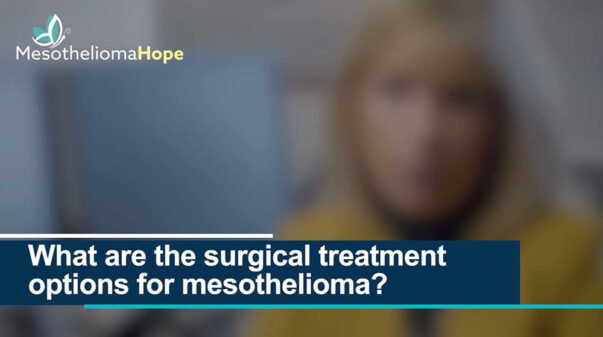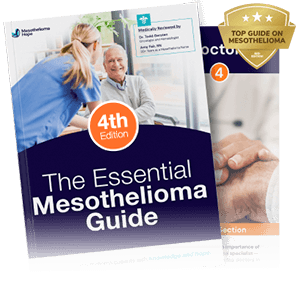EPP vs P/D Overview
Surgery is a significant part of many mesothelioma treatment plans. Both extrapleural pneumonectomy (EPP) and pleurectomy with decortication (P/D) are thoracic surgeries used to treat malignant pleural mesothelioma.
These surgeries are best suited for patients with early-stage (stage 1 or 2) pleural mesothelioma.
The main goal of these surgical interventions is to remove mesothelioma from the chest cavity before it has metastasized (spread to distant sites) and to prevent recurrence of the cancer.

Registered Nurse Amy Fair discusses mesothelioma surgery options and who may be a candidate. Call (866) 608-8933 to connect with Amy for personalized medical guidance. View Transcript.
Duration: 2 min 16 sec
What are the surgical treatment options for mesothelioma?
It’s important to talk to your surgeon and oncologist to see if you are a surgical candidate. Some folks that have extensive disease (cancer) are not a surgical candidate and they will start with other treatment modalities such as radiation and chemotherapy. With comorbidities such as diabetes, heart, and some lung conditions the surgeon may tell you you’re not a surgical candidate. Sometimes the cell type of your disease and the staging also drives if you are a surgical candidate or not for surgery.
Some of the surgeries performed for mesothelioma are a decortication, which is where they remove the lining of the lung, sometimes called a pleurectomy. There is a more extensive surgery called a pneumonectomy. That is where they remove the whole lung. There are surgical interventions for the peritoneal mesothelioma. Sometimes they will go in and do a recession of the damaged or diseased part of the intestines. There is a procedure called a HIPEC procedure where they go into the abdomen and they flood the abdomen with what is called a chemo wash. It is a more direct line and source of chemotherapy than the intravenous route.
Your surgeon will explain to you all the components of the surgery, pre-surgery, and post-surgery. They will tell you that you may have a chest tube. Many times, surgeries, decortications, things like that will cause the lung to collapse. That’s very normal so they will tell you that you may have a chest tube in place to inflate or to keep that lung from collapsing. Post-surgery it’s all about the healing phase. It’s about pain control. It’s about getting up and keeping your pneumonias down, getting up and being active. Post-surgery sometimes the patient is sent home with a catheter in their pleura called a pleura evac, pleura catheter where it continues to drain the fluid once the patient is at home. They will talk with them about good nutrition. They will talk with them about keeping their immune system strong so the healing process proceeded like it should.
Patients with late-stage mesothelioma may be eligible for palliative surgeries too. The goal in these cases is to relieve difficult symptoms such as pain and trouble breathing and improve quality of life.
Whether undergoing curative or palliative mesothelioma surgery, patients must be in good overall health to withstand the operation and any postoperative complications.
- Cancer surgeons often disagree about which procedure is most effective. However, P/D patients had better outcomes regarding 30-day mortality and median survival, according to a study published in Updates in Surgery in September 2022.
- P/D is safer. Approximately 2-7% of EPP patients will not survive the procedure compared to 1-5% of P/D patients.
- Mesothelioma clinical trials continue to study EPP and P/D in combination with other treatments such as chemotherapy, immunotherapy, and radiation therapy. For example, researchers are studying whether vaccines can be used to prevent cancer from coming back after EPP or P/D surgery.
Our team can help determine if an EPP, a P/D, or other treatments are right for your case. Learn more in our Free Mesothelioma Guide.
A Look at the 2 Surgeries
EPP, the more aggressive surgery, involves removal of the diseased lung, along with the pleura (lung lining), pericardium (heart lining), part of the diaphragm, and nearby lymph nodes. Recovery is extensive, with up to two weeks spent in the hospital followed by an additional three months of recovery at home or in a rehabilitation facility.
P/D is a two-part surgical procedure that spares the affected lung. Instead, the surgeon removes the lung lining during pleurectomy (and in some cases nearby chest cavity tissue) and visible tumors during decortication. Recovery is one week in the hospital and an additional month at home or in a rehabilitation facility.
The goal of a P/D is macroscopic complete resection, which means complete or almost complete removal of tumor tissue.
Both an EPP and a P/D are usually part of a multimodal treatment plan. This means that they are often used in combination with other mesothelioma treatments such as radiotherapy.
Choosing between the two surgical approaches is an important decision that you should make in consultation with a mesothelioma specialist.
Looking for a mesothelioma doctor near you? Our team can help you find one.
Difference Between EPP and P/D
Both the EPP and the P/D are major surgical treatments performed by only the top thoracic surgeons at mesothelioma cancer centers and other large medical centers. Patients should understand how the two procedures differ before, during, and after the operation.
Extrapleural Pneumonectomy Procedure
- Operation time: About 3 hours
- In-hospital recovery: Up to 2 weeks
- At-home recovery: About 3 months
Before surgery, doctors run a variety of tests to ensure you are healthy enough to undergo the operation. It is crucial that your lung function is sufficient for you to live with one lung and breathe without assistance. Doctors will also scan your chest cavity to confirm that the cancer has not metastasized to other areas.
EPP is performed under general anesthesia. The surgeon makes an incision along the front or side of the chest to enter the lung space. The surgeon then removes the affected lung, along with the pleura, pericardium, part of the diaphragm, and nearby lymph nodes.
Recovery is extensive. Doctors will prescribe a combination of rest and rehabilitation once you’re out of the hospital.
Pleurectomy With Decortication Procedure
- Operation time: About 5 hours
- In-hospital recovery: Up to 1 week
- At-home recovery: About 1 month
As with an EPP, patients must be in good general health to undergo a P/D procedure. Doctors will measure overall health and fitness, while also confirming tumor locations ahead of the decortication process.
A P/D is performed under general anesthesia. The surgeon makes an incision along the back and side to enter the chest cavity. Other incisions may be necessary if additional access points are required to remove tumors.
The surgeon first removes the pleura and possibly the pericardium, part of the diaphragm, and other diseased chest cavity tissue. In the decortication stage, the surgeon removes visible tumors and may use a variety of techniques to eliminate unseen mesothelioma.
Most patients are able to resume daily activities after the month-long recovery period at home. The most common complication is a prolonged air leak.
If you or someone you love is being treated for mesothelioma, our free Treatment Planner can help you stay organized.
EPP vs P/D Goals and Benefits
When performed on the right candidates, both mesothelioma surgeries offer the potential to extend life expectancy and relieve painful symptoms. However, the goals and benefits vary for each, depending on the patient’s mesothelioma stage and other factors.
Extrapleural Pneumonectomy Goals
The goal of an EPP is to remove as much cancer as possible to reduce the probability of metastasis (cancer spread) and recurrence.
While an EPP is considered radical surgery because it removes the entire lung, the recurrence rate after surgery is the lowest of the two procedures at 33%.
A palliative EPP may be an option for patients with late-stage mesothelioma. EPP patients suffer from pulmonary symptoms such as shortness of breath and coughing. EPP in these cases is not curative, but some studies suggest palliative treatment helps with the management of malignant pleural mesothelioma and may extend overall survival.
Pleurectomy With Decortication Goals
For curative P/D surgery, the main goal is to eliminate mesothelioma before it spreads. The 65% recurrence rate after P/D is higher than after EPP, but sparing the lung may be optimal for some patients.
Patients with late-stage mesothelioma who are in good general health may be eligible for palliative P/D. Removing tumor masses from the lung space eases difficulty breathing immediately after the operation and enhances patients’ quality of life.
EPP vs P/D Life Expectancy
Life expectancy refers to the average time patients can expect to live following surgery. Current statistics suggest EPP provides a longer life expectancy than P/D.
- Extrapleural pneumonectomy life expectancy: 10 to 35 months
- Pleurectomy with decortication life expectancy: 8 to 22 months
However, it is important to note that survival rate statistics are unique to each patient and the individual factors involved.
Patients who undergo either procedure can extend their life expectancy further by combining surgery with other treatments in a multimodal therapy approach. Your mesothelioma specialist may recommend a combination of chemotherapy, radiation, immunotherapy, alternative treatments (such as special diets or exercise regimens), or clinical trials.
EPP vs P/D Mortality Rates
Mortality rate refers to the percentage of patients who die during or shortly after the operation. Risk factors include the patient’s age, gender, mesothelioma stage, other medical conditions, and overall health.
- Extrapleural pneumonectomy mortality rate: 2–7%
- Pleurectomy with decortication mortality rate: 1–5%
Operating on and near vital organs always carries a risk of complication. However, new mesothelioma research and medical advances continue to lower the morbidity rate of both surgeries, as well as the probability of complications.
Not sure which mesothelioma treatment is right for you? Our list of important questions to ask your doctor can help you get the answers you need.
Choosing Between EPP and P/D
Medical professionals disagree about which mesothelioma surgery is most effective. Some doctors believe that the lower recurrence rate after EPP despite the removal of the entire lung offers patients the best prognosis. Other doctors think that the lung-saving P/D is the better option.
There are many facts to consider when choosing between EPP and P/D surgery. Contact one of our Patient Advocates today for more information about mesothelioma treatments and clinical trials.
EPP vs P/D FAQs
What's the difference between EPP and P/D?
Extrapleural pneumonectomy (EPP) and pleurectomy with decortication (P/D) are the two primary surgeries for patients with pleural mesothelioma.
An EPP is a much more aggressive procedure as the surgeon removes the diseased lung plus the tissue lining the lungs and heart.
In contrast, a P/D is a lung-sparing surgery. In this two-part procedure, surgeons first remove the lung lining and sometimes the heart lining and part of the diaphragm. Next, they remove visible and unseen tumors during decortication.
Which is better? EPP or P/D?
Even doctors specializing in mesothelioma can’t agree on whether extrapleural pneumonectomy (EPP) or pleurectomy with decortication (P/D) is the best surgical procedure to treat pleural mesothelioma.
EPP is a riskier surgery with mortality rates at 2-7% compared to 1-5% for P/D but has a lower recurrence rate (chance of the cancer coming back).
Patients recover more quickly from P/D and typically enjoy a higher quality of life.
How can I get an EPP or a P/D?
Patients researching treatment options should talk to their doctor about the treatment that is best for them. Call (866) 608-8933 to find top doctors now.
Either surgery may be available to early-stage pleural mesothelioma patients. EPPs and P/Ds are not used to treat other types of mesothelioma. Further, they may not be available to late-stage patients as the cancer may have spread too far.









